Refreshing Radio-Canada’s concourse
by Matthew | 24 January 2012 9:43 am
 [1]
[1]Photos courtesy Telecine Multimedia
By Peter Saunders
As one of Canada’s largest and most storied cultural institutions, the Canadian Broadcasting Corporation (CBC)/Radio-Canada had a wealth of content to showcase in 2011 when the time came to celebrate its 75th anniversary. One new vehicle for this content was an immersive, multi-screen digital signage project at Maison de Radio-Canada, the crown corporation’s regional headquarters in Montreal.
The concept that emerged for this project was to depict the past, present and future. Key moments in Radio-Canada’s history and ongoing development would be made readily accessible through interactive touch screens to the building’s 3,000 employees and 80,000 annual visitors.
The content would take them through a Canadian media journey, from radio and TV to the Internet and evolving social media outlets, including YouTube, Twitter and Facebook. Given CBC/Radio-Canada websites serve more than 7.5 million unique visitors per month, it seemed fitting for web-based media to become a key component of the digital signage.
Streamlining production
As a result, there were initially many stakeholders involved in the project, which caused some unanticipated delays. When Telecine Multimedia—a Montreal-based digital signage content provider and installer—came on board in late June 2011, it faced an aggressive five-week timeline for all creation, testing and implementation. The work would start on July 18 and needed to be completed by August 22, in time for the first in a series of Radio-Canada’s 75th anniversary celebrations.
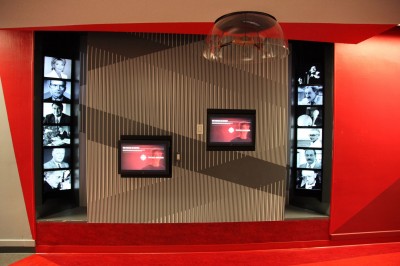 [2]
[2]Telecine Multimedia worked with Radio-Canada to keep content simple and engaging. Some screens use black-and-white photos, for example, to showcase notable past personalities.
So, Telecine enforced a point-person approach to ensure efficiency of communications and project management.
“Our first meetings were with 12 to 14 people,” says James Fine, Telecine’s president. “We were afraid they would all need to be involved in the entire process, but fortunately, Radio-Canada delegated the project to three key people before the work began.”
With services responsible to these three contacts, the company was able to deliver the custom content in a timely manner.
“There was nothing in the programming we hadn’t done before, so it wasn’t earth-shattering,” says Fine, “but it was a lot of interactivity to handle in that tight a timeline. We had to streamline our usual production process, as this kind of work would normally take three to four months.”
Managing content
Radio-Canada required a series of complex digital signage content templates and scripts, web browser integration and a custom interactive audio player. Telecine staff engineered these elements using out-of-the-box Scala software tools, without needing much new coding, while also consulting with the client to steer the project toward the most efficient, cost-effective, easily updated content templates.
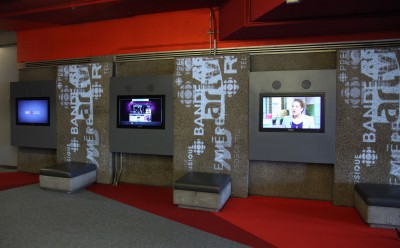 [3]
[3]Moving logos are digitally projected onto the walls at either end of the concourse.
“One of their requirements was the ability to manage content without needing special training,” says Fine. “Some of the news feeds, for example, come in from their system automatically.”
“The CBC people find it really easy to use this system and replace information,” says Larry Pieters, Telecine’s project manager. “We’re helping them design that content and use templates they can update.”
This complete, centralized content management system had to manage and update multiple types of display screens, with scalability for future expansion.
“Many people use this software for only a subset of what it can do,” says Fine. “This project used more of those capabilities. The platform lets us do almost anything and we have programmers on staff who do nothing else but work with it.”
Scala’s software was used somewhat similarly in 2010 during the Winter Olympics in Vancouver to support the Bell Ice Cube, an interactive video environment housed in a temporary (3,000-sf) structure. The centre attracted more than 4,000 visitors each day during the games, allowing them to watch teams compete in high-definition (HD) and to interact with Bell’s ‘smart cube’ displays.
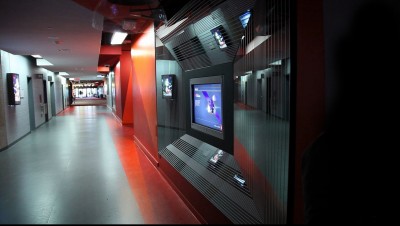 [4]
[4]Hardware installation was handled by the broadcaster’s own technicians, given their already-extensive experience with display equipment.
Another key factor in this regard for Radio-Canada was the fully bilingual content management interface for the Scala software. This meant in-house system users could operate in their choice of either French or English.
“They’re the largest single producer of French-language media anywhere in the world,” says Fine. “Our bilingualism, too, was an asset, as was our proximity. They’re within bicycling distance from our office.”
Sharing the concourse
The system was deployed within the facility’s 1-km (0.6-mi) long grand indoor concourse, which is accessible to the general public at all times, but by then was already overdue for a modernization effort to reflect the broadcaster’s creativity, current values and heritage.
Before Telecine’s involvement, Montreal-based Sid Lee Architecture had worked with Radio-Canada to design the concourse’s new look, including refreshed décor. As this process sketched out screen locations, it helped Telecine determine later to how to integrate digital signage into the environment, in terms of ambient lighting and sightlines.
“Radio-Canada had this project in mind for the space, which used to look like a grey cinder block,” says Fine. “Now, the displays are spread along the way. While they’re the most prominent feature, though, the concourse’s appearance is 90 per cent colour and lighting. It’s all part of the same project.”
Hardware installation was handled not by Telecine, as is sometimes the case with its other projects, but instead by the client. Given Radio-Canada is a broadcaster, after all, it has skilled technicians on staff who could handle the job just as well as anyone else.
“Sometimes we’re a technology integrator, but we rarely do everything ourselves,” says Fine. “We create the content and program the system. We don’t need to design the screen enclosures, for example. We aren’t control freaks. We like to work with partners.”
Another benefit of this partnership, as mentioned, was working with Radio-Canada’s sheer wealth of content.
“It was a treat to have the archived content ready,” says Fine. “It was a great opportunity to do something fun.”
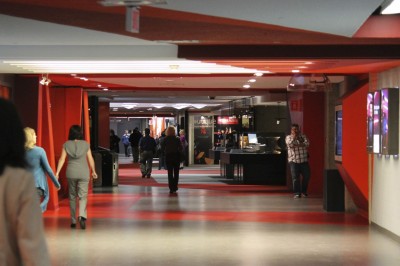 [5]
[5]The approximately 1-km long grand concourse at Maison de Radio-Canada was refreshed for the broadcaster’s 75th anniversary, setting the stage for the digital signage deployment.
“They had good ideas about what they wanted on the screens,” says Pieters, “but didn’t know how to get it there, as they had no direct experience with interactive digital signage, so we helped mould their vision. And the content was an embarrassment of riches, maybe even too much to handle! They’re digitizing everything these days.”
A diverse deployment
The system used 25 HP media players running Scala’s software to operate 46 screens, including LCDs featuring the crown corporation’s major accomplishments and awards, the interactive touch screens, projected displays with employee communications, a 4 x 1-screen video wall (using half-height displays) and more LCDs with schedules and coverage of live events.
Some screens feature black-and-white photos of notable past personalities. Digital projectors enable moving logos to appear on the walls at each end of the hallway. Another projection is dedicated to long-form international content.
“This kind of project shows how digital signage can be used in many effective ways,” Fine says. “Each screen is doing something different, but most of the content is fun, not complex. Great digital signage is about simplicity, taking away everything you can do without.”
Given the breadth of the project, Telecine had to turn to several manufacturers, including Panasonic, LG and Sharp, based on when they could deliver their hardware.
“Radio-Canada was manufacturer-agnostic,” says Fine.
As the project unfolded, however, it became apparent the timeline would not allow for the hardware to be fully tested prior to on-site installation. And unfortunately, several systems were found to be defective.
“It was the final weekend before the grand opening and we were not happy with the speed of response on some of the touch screens,” says Fine.
Telecine immediately sourced alternate personal computer (PC) units with similar specifications to deliver more reliable, optimal performance.
“We also couldn’t test the content here in our offices first, as there was no time to change things,” says Fine. “We had to ship the media players first, put them in place, get them working right away and then iron out any little details. Fortunately, the content’s really good.”
“Normally, any issues like this would not have to wait until the last weekend,” says Pieters.
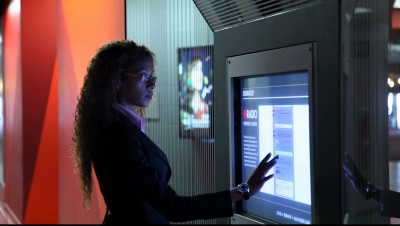 [6]
[6]Touch screens allow visitors to browse Radio-Canada’s online social media presence.
Future value
Radio-Canada held an open house celebration in early October 2011, attracting a turnout of more than 12,000 visitors. It was the first time the organization had held such an event in nearly 20 years.
“It was fun with working with creative people who understand good design and content,” says Fine. “You have to add value to a project, not just hang a screen on a wall. For our part, we brought our experience with interactivity.”
Telecine is also remaining involved in the project in a limited fashion, answering technical questions, training new Radio-Canada staff and handling ongoing maintenance. The goal is to ensure the 75th anniversary project can prove perennial.
“There are lots of employees and visitors,” says Fine. “When they pass by a screen again, there needs to be new stuff on it, to satisfy both of those groups.”
With files from Scala Canada. For more information, visit www.scala.com[7].
- [Image]: http://www.signmedia.ca/wp-content/uploads/2014/02/RS5799_SRC-03.jpg
- [Image]: http://www.signmedia.ca/wp-content/uploads/2014/02/RS5801_SRC-05.jpg
- [Image]: http://www.signmedia.ca/wp-content/uploads/2014/02/RS5800_SRC-041.jpg
- [Image]: http://www.signmedia.ca/wp-content/uploads/2014/02/RS5798_SRC-02.jpg
- [Image]: http://www.signmedia.ca/wp-content/uploads/2014/02/RS5802_SRC-06.jpg
- [Image]: http://www.signmedia.ca/wp-content/uploads/2014/02/RS5797_SRC-011.jpg
- www.scala.com: http://www.scala.com
Source URL: https://www.signmedia.ca/refreshing-radio-canadas-concourse/